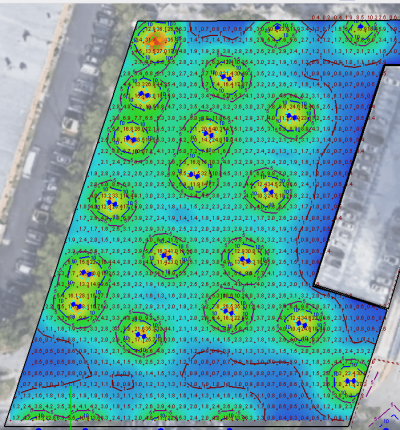Understanding the role of MEP systems in ensuring occupant safety When it comes to ensuring the safety and well-being of

Introduction
Nowadays, building owners are upgrading their existing fixtures to LEDs or installing new lighting. While doing this, there is one big challenge most of them encounter! That is, anticipating how the new lights will function or look in the new space. If you’re experiencing the same problem, worry not! You just need a photometric plan and you’re good to go!
This plan will help you understand the lumen power and output for the lights you want to install. This lighting diagram is very useful to everyone in the landscape lighting industry. This includes photometric plan designers, architect specifiers, distributors, and manufacturers.
But, what exactly is a photometric plan? You’ll find that out and much more in this article. So, keep reading!
A photometric plan is your site’s digital survey with regard to lighting solutions. It’s a scaled diagram showing the position of light fixtures and light poles on the site. Also, it contains a mathematical grid of the lighting levels produced by the fixtures.
In simple terms, it illustrates the locations of lighting fixtures and illumination levels. It shows the location, types, and height of lighting fixtures on the proposed building and site. This allows you to see the level of lighting at the site before construction commences. It ensures the property accomplishes illumination specifications recommended by the local building authority.
In commercial or large spaces that need major lighting, a photometric plan has a crucial role. It enables photometric plan designers to determine if space has enough lighting. This includes confirming light evenness, brightness, intensity, and more. Better still, it allows them to create a photometric design for the area’s electrical needs and determine the cost.
A photometric plan is also known as a photometric light study/ photometric analysis!
The development of photometric plans started in the early 1990s. This was propelled by technological advancements and the lighting industry’s competition. However, photometric plans were properly archived after the formation of IES. This also led to the development of photometric studies.
There is special software that lighting designers use to create photometric plans. First, this software helps them to recreate your project site in 3-D CAD format. This includes cleating a simulation of an outdoor or indoor space. Moreover, it can import CAD files as well as layouts. It can even import scaled outdoor spaces from google maps. This is an interesting feature, especially in an outdoor sports facility project.
After transferring the project into 3D files, they can place the fixtures in the plan. The software allows them to position the fixtures are specific heights and locations. Every placed fixture creates a numerical figure that should pass the lighting requirements. Some of these calculations are;
A photometric analysis will also provide a comprehensive PDF report. It also demonstrates how the light is balanced.
There are many reasons that can prompt you to do a photometric study for your project. However, the most common ones are;
A lighting plan plays an important role in ensuring enough light distribution. Insufficient light distribution can lead to accidents. Also, it can make a certain room have dark corners.
Also, it’s an incredible way of analyzing lighting solutions. This helps you to determine the light output in a certain area before you buy any type of luminaires. Without a photometric plan, it’s difficult to adjust the plan and design the right type of output.
The bottom line, a photometric plan is a crucial document in any project. The people who need it include; landlords, remodelers, property managers, and construction builders. Moreover, the city building department will need it for your project to get approved.
As we stated earlier, photometric plans are usually created by photometric plan designers. However, you can also contact an architect or a lighting retrofit firm to create one for your project. Any of these professionals can design the plan for you. But only a light retrofit company can create a photometric design and install the lighting fixtures.
If you live in California, contact Innodez Design and Engineering for photometric plans. Our licensed lighting designers prepare and certify photometric plans. This helps you to pull permits quickly and supports site plan applications. Besides, a great lighting design will help your property achieve its lighting goals. Not to forget that it can increase the property value dramatically!
About Author
InnoDez